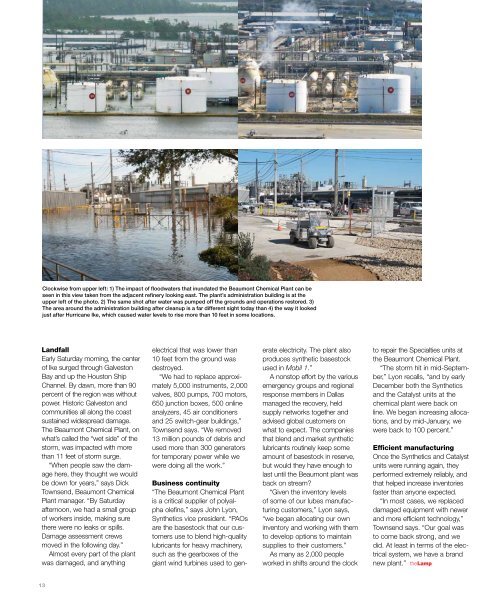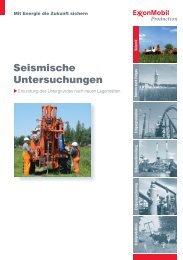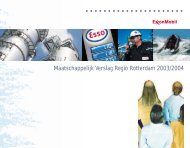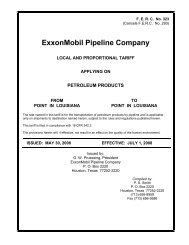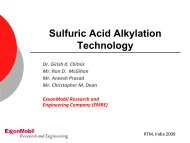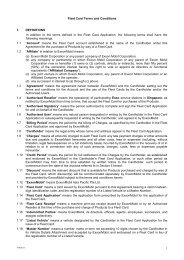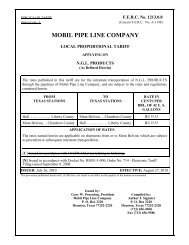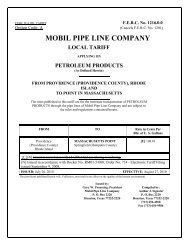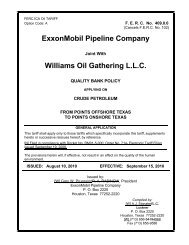ExxonMobil and Abu Dhabi
ExxonMobil and Abu Dhabi
ExxonMobil and Abu Dhabi
You also want an ePaper? Increase the reach of your titles
YUMPU automatically turns print PDFs into web optimized ePapers that Google loves.
Clockwise from upper left: 1) The impact of floodwaters that inundated the Beaumont Chemical Plant can be<br />
seen in this view taken from the adjacent refinery looking east. The plant’s administration building is at the<br />
upper left of the photo. 2) The same shot after water was pumped off the grounds <strong>and</strong> operations restored. 3)<br />
The area around the administration building after cleanup is a far different sight today than 4) the way it looked<br />
just after Hurricane Ike, which caused water levels to rise more than 10 feet in some locations.<br />
L<strong>and</strong>fall<br />
Early Saturday morning, the center<br />
of Ike surged through Galveston<br />
Bay <strong>and</strong> up the Houston Ship<br />
Channel. By dawn, more than 90<br />
percent of the region was without<br />
power. Historic Galveston <strong>and</strong><br />
communities all along the coast<br />
sustained widespread damage.<br />
The Beaumont Chemical Plant, on<br />
what’s called the “wet side” of the<br />
storm, was impacted with more<br />
than 11 feet of storm surge.<br />
“When people saw the damage<br />
here, they thought we would<br />
be down for years,” says Dick<br />
Townsend, Beaumont Chemical<br />
Plant manager. “By Saturday<br />
afternoon, we had a small group<br />
of workers inside, making sure<br />
there were no leaks or spills.<br />
Damage assessment crews<br />
moved in the following day.”<br />
Almost every part of the plant<br />
was damaged, <strong>and</strong> anything<br />
13<br />
electrical that was lower than<br />
10 feet from the ground was<br />
destroyed.<br />
“We had to replace approximately<br />
5,000 instruments, 2,000<br />
valves, 800 pumps, 700 motors,<br />
650 junction boxes, 500 online<br />
analyzers, 45 air conditioners<br />
<strong>and</strong> 25 switch-gear buildings,”<br />
Townsend says. “We removed<br />
13 million pounds of debris <strong>and</strong><br />
used more than 300 generators<br />
for temporary power while we<br />
were doing all the work.”<br />
Business continuity<br />
“The Beaumont Chemical Plant<br />
is a critical supplier of polyalpha<br />
olefins,” says John Lyon,<br />
Synthetics vice president. “PAOs<br />
are the basestock that our customers<br />
use to blend high-quality<br />
lubricants for heavy machinery,<br />
such as the gearboxes of the<br />
giant wind turbines used to gen-<br />
erate electricity. The plant also<br />
produces synthetic basestock<br />
used in Mobil 1.”<br />
A nonstop effort by the various<br />
emergency groups <strong>and</strong> regional<br />
response members in Dallas<br />
managed the recovery, held<br />
supply networks together <strong>and</strong><br />
advised global customers on<br />
what to expect. The companies<br />
that blend <strong>and</strong> market synthetic<br />
lubricants routinely keep some<br />
amount of basestock in reserve,<br />
but would they have enough to<br />
last until the Beaumont plant was<br />
back on stream?<br />
“Given the inventory levels<br />
of some of our lubes manufacturing<br />
customers,” Lyon says,<br />
“we began allocating our own<br />
inventory <strong>and</strong> working with them<br />
to develop options to maintain<br />
supplies to their customers.”<br />
As many as 2,000 people<br />
worked in shifts around the clock<br />
to repair the Specialties units at<br />
the Beaumont Chemical Plant.<br />
“The storm hit in mid-September,”<br />
Lyon recalls, “<strong>and</strong> by early<br />
December both the Synthetics<br />
<strong>and</strong> the Catalyst units at the<br />
chemical plant were back on<br />
line. We began increasing allocations,<br />
<strong>and</strong> by mid-January, we<br />
were back to 100 percent.”<br />
Efficient manufacturing<br />
Once the Synthetics <strong>and</strong> Catalyst<br />
units were running again, they<br />
performed extremely reliably, <strong>and</strong><br />
that helped increase inventories<br />
faster than anyone expected.<br />
“In most cases, we replaced<br />
damaged equipment with newer<br />
<strong>and</strong> more efficient technology,”<br />
Townsend says. “Our goal was<br />
to come back strong, <strong>and</strong> we<br />
did. At least in terms of the electrical<br />
system, we have a br<strong>and</strong><br />
new plant.” the Lamp


